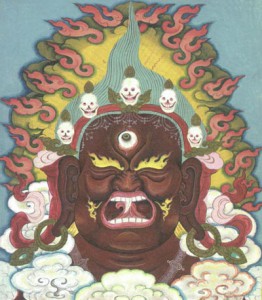Monday
Community ArticlesAppeasing the Mamos
by Shambhala Times Regional Correspondent Travis May
Yesterday I sat down for an early dinner with my meditation instructor, the world-famous Shambhalian Will Ryken, after a nice two hour practice session at our center in St. Petersburg, Florida. As one of the original Dorje Kasung (and recently appointed Dapons) and long-time practitioner and insider in our community, I wanted to get his take on the dön season and mamo chants. Dapon Ryken will be leading the mamo chant practice at our center in St. Petersburg daily throughout the dön season (Feb. 11-20) again this year.
If you have done the protector chants (Four Armed Mahakala, Vetali, Concluding Request to the Protectors, etc.) before at a Shambhala center at the end of a day of practice, you will already have an idea of what mamo chants entail. It is customary to do the protector chants at dusk, a time of day when our attention and mindfulness are more likely to waver, and as a result accidents and other adverse circumstances are more likely to occur.
The days leading up to the new year (Shambhala Day, which this year is Wednesday, February 22nd), known as the the dön season, are a time when we are especially susceptible to our pent up negative karmic energies, and the mamo chants help to overcome setting sun vision and to reconnect with the outlook of the Great Eastern Sun.
 The deities or dharmapalas (dharma- truth, teachings, palas- protectors) symbolized in the protector chants are, in one sense, projections of our own inherent potentialities to overcome these obstacles. So, in supplicating them, we are arousing our own inherent wakefulness and confidence to rise above these negative energies.
The deities or dharmapalas (dharma- truth, teachings, palas- protectors) symbolized in the protector chants are, in one sense, projections of our own inherent potentialities to overcome these obstacles. So, in supplicating them, we are arousing our own inherent wakefulness and confidence to rise above these negative energies.
Dapon Ryken remembers doing mamo chants since we began celebrating Shambhala Day in the late 70’s. When I asked what we were actually doing when we did mamo chants, he said, “We’re waking up the protective energies in the local area.” The practice is connected with playing with phenomenal energies, he said, and is therefore related to the vajrayana path.
Dapon Ryken said that as we begin to connect with the vajrayana path, “We are playing more with the phenomenal energies in the world and are therefore more susceptible to mishaps.” That’s why we should do protector chants, he said. When doing so, we are inviting the wisdom beings – the innate purity of everything that is taught on the vajrayana path.
He said that this practice is very much connected to the mandala principle and to interconnectedness. Dapon Ryken said there is a great example of this in the movie Hugo (which he highly recommends). In the movie, an analogy is given about how a machine doesn’t have any spare parts. Each piece is necessary and serves a purpose. Without a single piece the whole thing falls apart. In the same way, everything that exists, phenomenally, is the effect of previous causes and conditions. Nothing is here that isn’t supposed to be, or that could not be, and in this way everything is sacred.
As the protector chants are done at dusk each day, the mamo chants are done at the end of each lunar year. They are a more elaborate protector chant to help dispel the negative energies that accumulate during the entire year. At the end of the year, perhaps illustrated better in cold weather climates (we decided to eat inside yesterday because it was pretty hot), and being stuck indoors a lot, we can experience a sense of a let down or complacency. He went on to say, “We invite the things that keep us awake – like wheel chairs in the road.” (On our way to the restaurant we witnessed an elderly gentleman hit a woman on a motorized wheel chair with his BMW sports car. Thankfully, she wasn’t badly injured and we were able to call for help and get her back on her chair.) “He should have been doing protector chants,” said Dapon Ryken.
When I asked him if doing these practices could be beneficial to completely new people to the path, he said, yes, even if it’s just to awaken their curiosity. Engaging with protector practice can awaken our mindfulness and awareness at a time when we are likely to put down our guards and help us reconnect with basic goodness.
Dapon Ryken said that as kasung, we invite all of this energy into our situation all of the time when working with the environment. This is why, on the last dön day (two days before Shambhala Day), which is considered the biggest day of chaos and obstacles, the kasung throw a party.
“Never give a sword to a man who can’t dance.” – Confucius
If you would like to come visit us in St. Petersburg and spend a whole week with Dapon Ryken, he will be leading a weekthun at our center, April 23-29. Please click here for more information on that event.





Feb 14, 2012
Reply
Thank you, Travis! Thank you, Dapon Ryken Rupon!